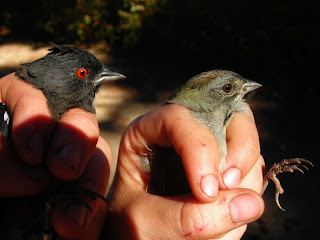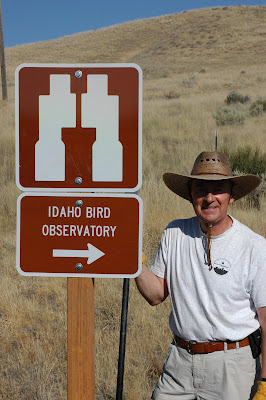First, let me apologize for the long delay between posts ... With several new crewmembers coming on board and both raptor projects starting in the last week, things have been busier than usual of late.
That said, it's been a pretty exciting 10 days up on Lucky Peak as bird migration study is now occurring 24-7! Songbirds have been moderately busy but very diverse over the last 10 days (see season totals below).
The hawk migration count began Sat, Aug 25 and hawk trapping began the next day. The hawk count has been relatively slow so far but is starting to gain momentum; meanwhile, hawk trapping has been quite successful - especially considering that no big flights have occurred yet. The 2006 hawk flight was the lowest in the 12 years of standardized monitoring at Lucky Peak (a pattern also observed at most other count sites in the West last year but we don't really have a sense for what caused the dip in #s); thus, it will be interesting to see whether 2007 brings some recovery.
The owl study began on night of Tues, Aug 28 and a Flammulated Owl was captured in the 1st net run of the season (we hoped this would be a good omen) but we haven't caught another owl since. Owl banding is usually best after Sept 15 .... We did catch a Pallid Bat on the 29th and, knock on wood, we haven't captured a flying squirrel yet!
Now for the songbird #s. From July 16 through August 31, we captured 2,885 birds of 52 species. Since the year 2000 (when we standardized our start date at mid-July), this is the 2nd highest mid-season total - 2nd only to 2,893 birds captured by Aug 31 in 2006. Thus, we are only 8 birds off the record 2006 pace - most mid-season totals have been between 2,100 to 2,300 birds. A Green-tailed Towhee (our 4th in 11 years at Lucky Peak) was new for the season on 31 Aug and we caught our first 2 White-crowned Sparrows on 1 Sep.
I didn't bring all of the exact #s with me but the top ten species through Aug 31 were:
1) Dusky Flycatcher (312)
2) Yellow Warbler (
278 - a single-season record)
3) MacGillivray's Warbler (~ 250)
4) Yellow-rumped Warbler (~230)
5) Western Tanager (190)
6) Spotted Towhee (~140)
7) Chipping Sparrow (~130)
8) Warbling Vireo (~120)
9) Nashville Warbler (~120)
10) Brewer's Sparrow (
80 - a single-season record)
Though less impressive (it seems that this species is more common as a spring migrant in southern Idaho), we are also at a single-season record for Swainson's Thrushes (
22; previous record was 20). Also, we are now starting to transition from Neotropical migrants to temperate migrants - juncos, kinglets, and WC Sparrows will all become more common in the next couple weeks while most longer-distance migrants will start to diminish in #s.
Now, a few pics:

Spotted (adult) and Green-tailed (immature) Towhees; Aug 31, 2007. This is the 4th Green-tailed we've captured in 11 seasons - all since 2004. Note the difference in eye color.

A closer view of the same adult Spotted Towhee.

(Apologies for the terrible photo quality, especially to John ;-) ... in the last week, we were excited to get a visit from Caroline and John ... our Lucky Peak MVPs over the last 2 seasons while I was away working at Camas NWR. They enjoyed some songbird banding (& the 2007 crew enjoyed working with them as well), some hawk trapping, and ....

.... a visit from their pal, Gary Robinson (center) - our songbird MVP volunteer over the last few seasons (also shown here with Craters of the Moon biologist Mike Munts).
Cheers & happy September,
Jay



















































